CEDAR BREAKS (Day 18 - part 4)
Next came the big Hunter house. As I entered, I was greeted by a lovely woman who gave me an excellent tour.
Joseph Sneddon Hunter was born into a Mormon family in Scotland in 1844, and in 1849, the entire family moved to the States. Within very short time, Joseph's mother and two siblings died. So his father took his sons to Utah to help colonize Cedar City.

Joseph made is living in farming and livestock. In 1865 he married Eliza Catherine Pinnock and they began work on this house. It was built in three stages (to accommodate their expanding family of eventually 10 kids), ending with an addition in 1924. Joseph died in this house in 1904.

In 2005, the front half Hunter house was relocated to where it stands now. Eventually the museum will rebuild the second part of house.

This is what the whole house used to look like in its original location. It used to be listed on the National Register of Historic Places but was delisted in 2007 after being moved here.

The main room

My wonderful tour guide


So many interesting choices... Treble Couplet, Clarinet, Piccolo, Cello, Melodia, Principal, Trumpet...
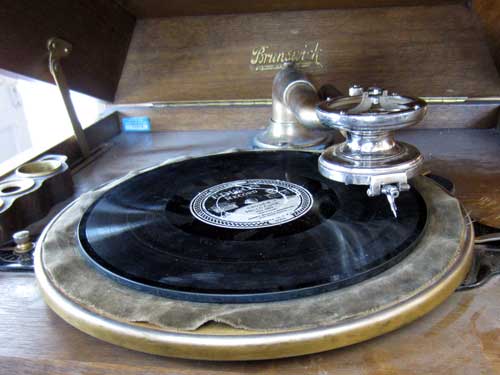
These early record players were not electric... they were hand-cranked. It took several vigorous cranks to play one song. Between dancing and winding, it was quite an exhausting form of entertainment!
We then headed upstairs.
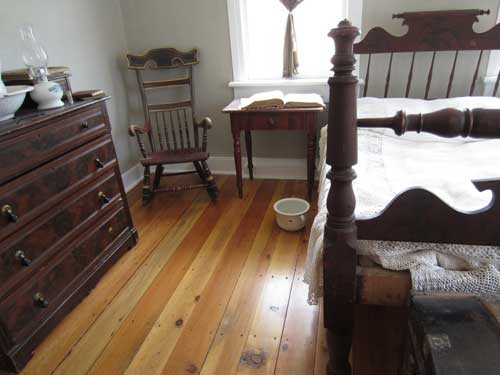
Settling the frontier wilderness could be a lonely business. Many of the pieces of furniture were built in styles that reminded people of their former lives and homes.

If you looked closely at the bed, you could see pieces of rope sticking out. Back then, beds were wooden frames with pegs so that ropes could be pulled very tightly across it to create a woven framework. By morning, however, the ropes had loosened and had to be pulled tight again... hence the origin of the phrase "sleep tight." In some cases, mattresses were added on top, but these were stuffed with straw (making a lovely home for many critters)... which finished off the nightly phrase with "and don't let the bedbugs bite."
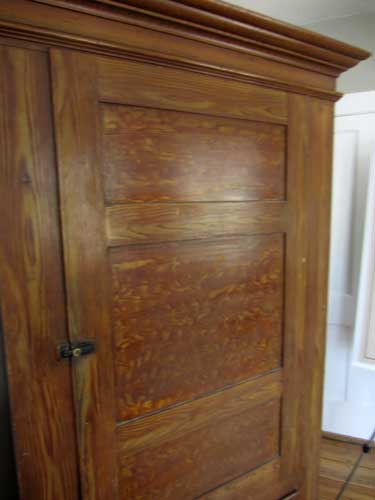
In the early days, raw materials for furniture was limited to native trees and plants. Importing supplies from back East was expensive. Fortunately there was an abundance of pine, spruce, fir, maple and poplar which were familiar to migrating pioneer craftsmen. With the completion of the Trans-Continental Railroad in 1869, variety was once again readily available.

The wood pattern in the piece above is known as Bird's Eye. It's not known what causes these small, swirling eyes. This feature is most notably found in hard maple. Bird's eye maple can be expensive, up to several times the cost of ordinary hardwood.
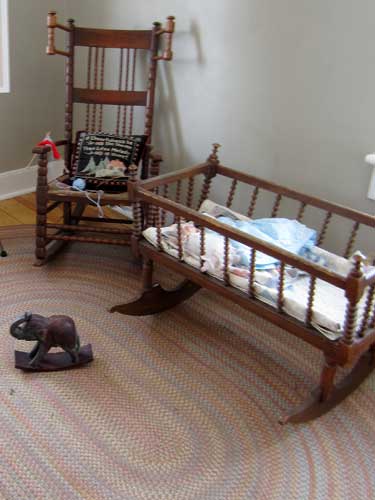
The design of the Mormon Rocker reflects English designs from the early 1700s.

The house is built using two rows of bricks with space (air insulation) between them, so it keeps cool in summer and warm in winter.

Once again outside, it's obvious from the side of the house that much of it is missing!
Next... a sheep shearing shed from the 1920s.

Is the ramp meant for us... or sheep? Or is there really a difference sometimes??

From 1851 - 1857, the main industry in this area was the mining of iron ore. But in 1858, hard times caused production to cease, and the local population dropped from over 1,000 to just 300. Fortunately, they were saved by the sheep industry until the mines reopened in the early 1920s.

Prime specimens
The first sheep had been brought in around 1852, primarily for wool for spinning and weaving family clothing. They were valued at $30 per head, were kept in pens at home, and hand-fed. Once the sheep industry exploded, however, it became a burden to care for them in these tiny residential lots. Eventually larger flocks were herded out to live off the land and brought into town only once a year to be sheared.
By 1879, there were more than 5,000 sheep in the local herds, providing sufficient wool. For meat, 25 - 30 ewes were slaughtered every week. Plucks (the heart, liver and kidneys) were given to the kids who eagerly swarmed the slaughterhouse. All I can say here is eeeeew (not ewe)!
The industry faded once mining returned.

Summer grazing range
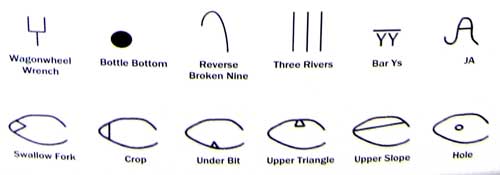
Unlike cattle and horses, sheep are not branded (since they have all that thick wool in the way). Instead their brands are painted on. They are also earmarked (which means making a cut in the ear, since the painted brand can be easily sheared off).
In the old days, shearing methods were crude and time-consuming. Shearers were paid by the sheep at 5 cents per head. A shearer would have to run into the large corral, catch a sheep, then drag it back to the shearing house. He'd then have to cut the wool off using manual shears. Once completed, he'd put a tally mark next to his name on a board.... aaaand repeat for the entire day. Sometimes a shearer would try to go too quickly and end up killing the sheep by slicing a vein. That would cost a day's wages.
Electric clippers came onto the scene in the 1920s. A sheep could now be sheared in a third of the time. A man could now shear about 150 sheep in an 8 hour period.

Grab your sheep and begin clipping!

Parts from the electric shearing stations
Once a sheep has been sheared, there are a series of steps to treat the wool:
Sorted: Different parts of the sheep provide different length and texture of wool. For example, clothing uses wool from the shoulder, neck, sides and back. Rugs use wool from the haunches, tail and hind legs.
Washed: It's then washed in warm water to remove some of its lanolin (grease). This makes it easier to work with and to dye.
Teased: This is done by pulling it apart with your hands. It opens the wool and removes any stuck dirt and plant material.
Carded: This procedure separates and straightens the wool fibers. It can either be done by hand (combing it back and forth between two large paddles with teeth) or by machine.
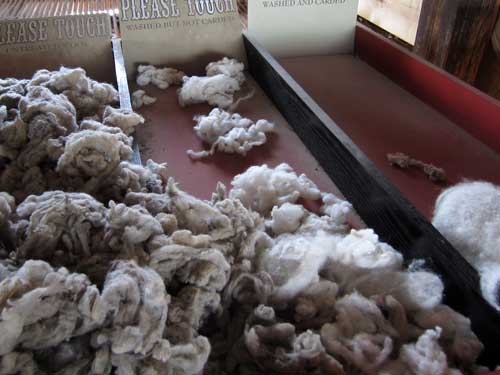
Left (greasy, untreated wool), middle (washed), right (washed & carded)
What's the difference between 'wool' and 'fleece?' Well, first off, there apparently is no standard definition. Different regions and cultures each have their own terms. Sometimes it's the difference between being 'on' versus 'off' the sheep; other times it's the difference of being washed or not; and still other times it depends on the type of animal (sheep vs llama)... then you get into a whole different set of definitions once it's made into clothing!
Spinning turns the raw fleece into yarn or thread. Multiple strands can be twisted together to create thicker yarns. A skeinwinder keeps the yarn in organized, untangled loops. It could then be put on a loom and woven into fabric or rugs.

A spinning wheel (front) and skienwinder

A loom
Wool that was being sold was stuffed into sacks. Originally the sacks were placed on the ground and the men would stuff the fleece into it with their feet while laying partially in the bag. Then someone came up with the idea of hanging the bags from the ceiling, throwing all the fleece into it at once, and simply jumping on it until it compressed. This allowed a third more wool per bag, saving lots of time and money.

In an enormous 'garage' were a vast number of wagons and carriages awaiting repair.



Uh oh, these horses are being made to stand in the corner. Where are their dunce caps?
According to oral history, the Southern Paiute arrived in Utah over 700 years ago. HIstorically, they lived under rock overhangs and in brush shelters called wickiups, which were made from locally available resources (such as grass, cattails, willows, pine branches, etc). They fished, hunted, gathered seeds and nuts, and even had gardens.

Gathering seeds in home-made baskets
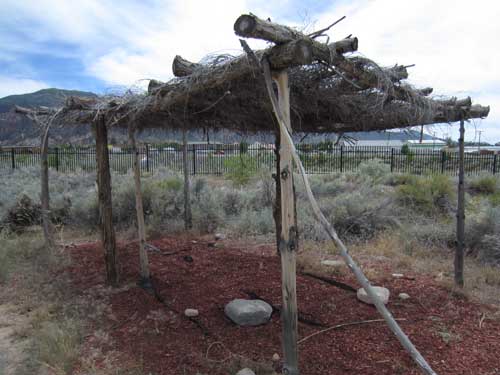
A shelter from the elements
There was also a section on tools of the iron ore mining industry.
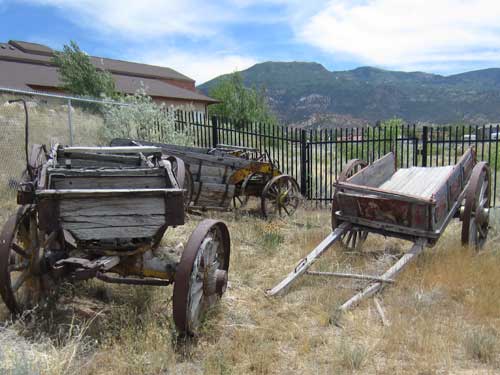
Miners had dump wagons (for bigger loads where the bottom would open up) as well as dump carts (for smaller loads that could be tipped out the back).

This is a sintering machine. Sintering is the process of causing a metal substance (such as metallic powder) to form a coherent mass. This high-temperature processing did not melt the substance but rather helped to improve the properties of the ore.

Ready to go into the mine!

The earliest wells date back as far as 10,000 years ago. But these were simple, hand-dug pits where the water table was close to the surface. The Chinese are credited with developing the percussion method of well construction some 4,000 years ago. They could drill wells to depths of 3,000 feet (although granted, this would take several generations to complete). By the 1870s, designs were more innovative; horse-power had been added; and platforms with wheels provided for portability.

As if I weren't already super impressed with this place (did I mention it only cost $3 to get in??), there was a complete, working saw mill!
The Jensen Sawmill was built around 1933 by John Robert Jenson and George Wood. It originally stood near Mammoth Creek, about 35 miles away. Eventually it got passed down to Heber Jensen and was used to help build the current-day university in 1898. It ran until the late 1990s and was moved here in 2010.


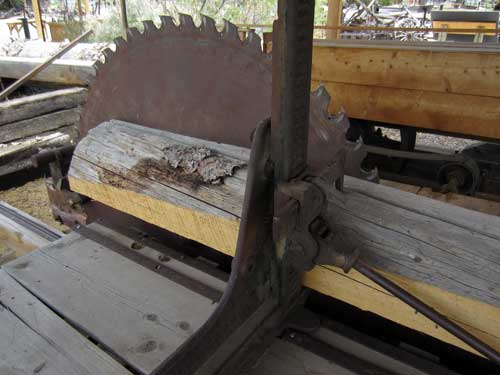

Um... this probably doesn't conform to modern-day safety codes, but hey, if it works!
Among the vast array of equipment scattered about the area were things such as scrapers, land rollers, hay bailers, harrows, reapers, mowers, plows, sulkys and many more things I'd never heard of before.


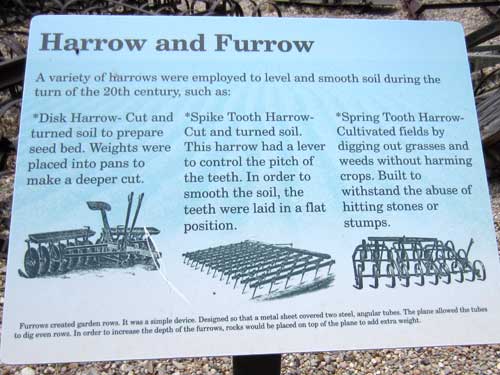


return • continue

